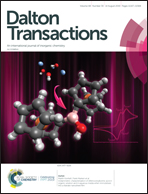A lactam-functionalized copper bent diisophthalate framework displaying significantly enhanced adsorption of CO2 and C2H2 over CH4†
Abstract
The design and construction of porous materials for high-efficient adsorption-based separation of CH4 from C2H2 and CO2 is a fundamental goal in the chemical industry. In this work, a lactam-functionalized bent diisophthalate linker, 5,5′-(1-methylpyridin-2(1H)-one-3,5-diyl) diisophthalic acid, was judiciously designed and utilized to construct a dicopper paddlewheel-based MOF under solvothermal conditions. Single-crystal X-ray diffraction revealed that the resulting solid is a three-dimensional mfj-type network incorporating Lewis-acidic copper sites and accessible lactam groups as two different kinds of functional sites. Furthermore, gas adsorption studies indicated that the material exhibited great promise for C2H2/CH4 and CO2/CH4 separations. In particular, compared to the unmodified parent compound, the resultant MOF exhibits 9.4% and 12.9% higher C2H2 and CO2 uptake capacities and 48.0% and 28.3% higher C2H2/CH4 and CO2/CH4 adsorption selectivities for the equimolar gas mixtures at 298 K and 1 atm, despite the lower specific surface area and pore volume. This work reported the first lactam-functionalized MOF displaying significantly enhanced adsorption of CO2 and C2H2 over CH4.



 Please wait while we load your content...
Please wait while we load your content...